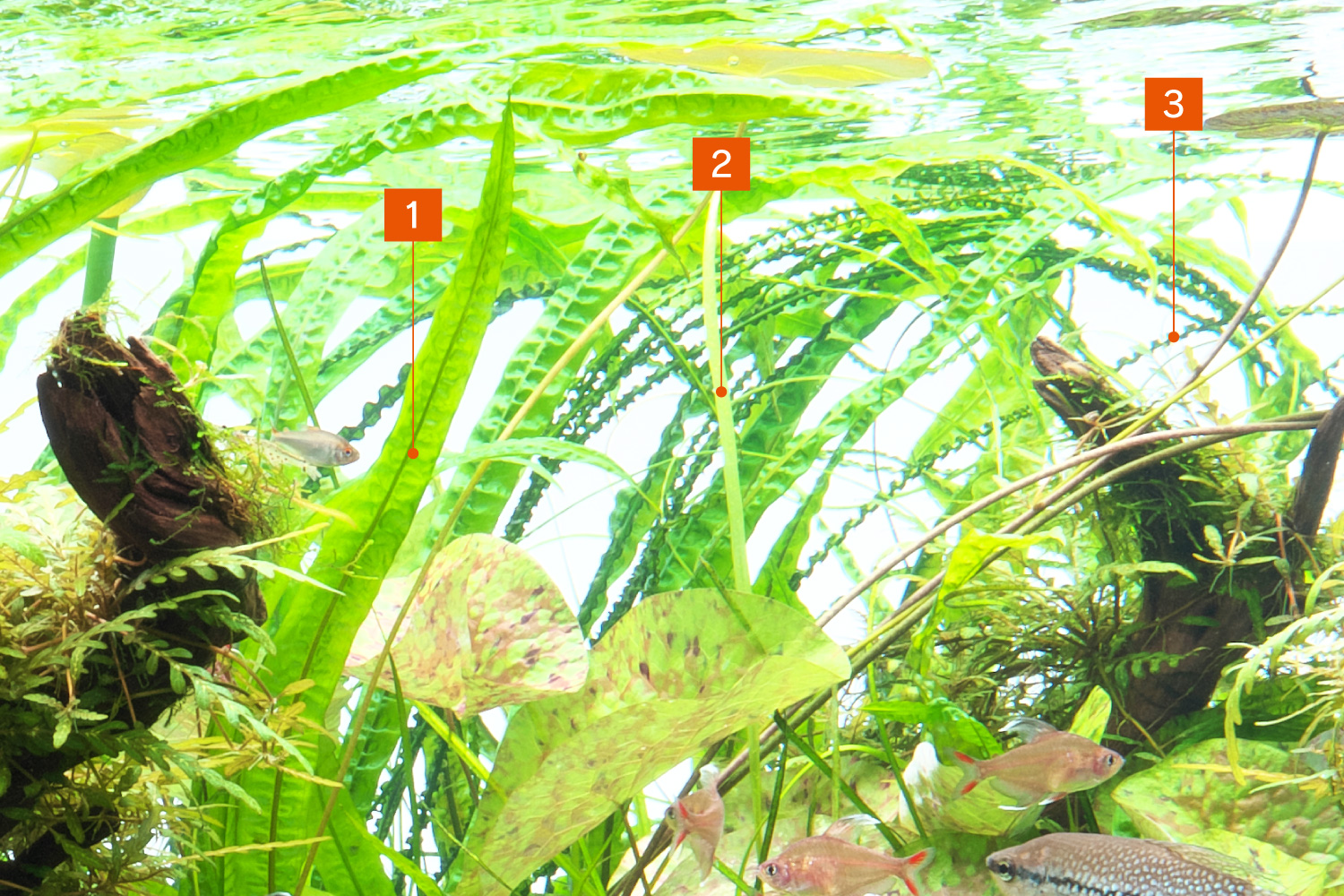
Photo taken on: June 10, 2021 (ADA)
Creator: Daichi Araki (layout production, text)
Aquarium: Cube Garden W150×60×H60(cm)
Lighting: Solar RGB x 3 (8.5 hours per day)
Filtration: Super Jet Filter ES-2400 (BioRio)
Material: Branch Wood, Sansui Stone
Substrate: Aqua Soil – Amazonia Ver.2, Power Sand Advance L, Bacter 100, Clear Super, Tourmaline BC
CO2: Pollen Glass Beetle 50Ø, 5 bubbles per second via CO2 Beetle Counter (using Tower)
Aeration: 15.5 hours after the light is turned off using Lily Pipe P-6
Additives: Brighty K, Green Brighty Mineral, Green Brighty Iron, Green Brighty Nitrogen
Water change: 1/3 once a week
Water quality: Temperature 25°C, pH: 6.2, TH: 50 mg/LPlants
Hygrophila pinnatifida ‘Uttarakannada’
Nymphaea sp. ‘Iquitos’
Nymphaea micrantha
Cryptocoryne wendtii ‘Tropica’ (BIO)*
Cryptocoryne wendtii ‘Brown’ (BIO)*
Cryptocoryne axelrodi (BIO)*
Cryptocoryne crispatula var. balansae
Crinum calamistratum
Helanthium bolivianum ‘Angustifolius’
Helanthium tenellum (BIO)*
Vallisneria spiralis
Vallisneria nana
Glossostigma elatinoides (BIO)*
Taxiphyllum barbieri (Moss Bag)*
Fish and Invertebrates
Trichogaster leeri
Hyphessobrycon rosaceus var.
Hyphessobrycon coelestinus
Crossocheilus oblongus
Otocinclus sp.
Caridina multidentata
* means that they are from ADA’s living product lineups.

By selecting Hygrophila pinnatifida ‘Uttarakannada’ instead of darker ferns from epiphytes, I tried to avoid having the same color as the middle ground or the background. In particular, the aim was to avoid the aquascape from looking overly subdued by contrasting with the brownish hue of the Cryptocoryne. The plant tends to take root quickly, and the amount and balance of the plant can be easily adjusted, making it easy to keep the plant in good condition.


[Material]Maintainability is improved with the minimum amount of Sansui Stone required.
In maintaining an aquascape over a long period of time, a complicated stone arrangement may hinder maintenance. Although the stone arrangement was designed with simplicity in mind, slightly larger Sansui Stones were placed in the foreground to add accent to the aquascape so that the presence of the stones will remain even after the Cryptocoryne and Nymphaea thrive.


[Planting]Mixed of three tape-shaped aquatic plant species
When tape-shaped aquatic plants are planted in the background, a natural mixture can be created by having various leaf shapes and colors. Compared to a background of stem plants, this type of background requires less maintenance and is relatively easy to maintain the aquascape. Although the density of the middle ground is high, gaps are effectively created by leaving some spaces in the background, resulting in an aquascape that does not feel oppressive.
1 Cryptocoryne crispatula var. balansae
2 Helanthium bolivianum ‘Angustifolius’
3 Crinum calamistratum

[Maintenance]Maintenance by thinning and fertilizing
I left it to the growth of the aquatic plants to some extent for this aquascape when it comes to maintenance because I purposely planted a lot of aquatic plants that are relatively easy to maintain. By thinning out overgrown runners and overspread leaves and creating impressive contrasts of the aquatic plants cluster, the aquascape became more attractive.



Completion
Source # Aqua Journal vol.329, © ADA Aqua Journal



